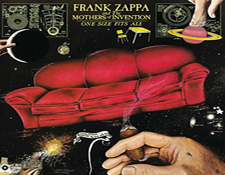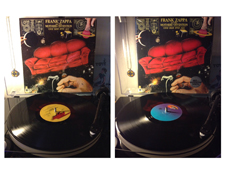It’s the time of year for saving money!
I’m going to take a little cue from Patti Smith in writing this review. I’ve been reading her latest book M Train and it is an interesting journey.
She opens her tale with the line “It’s not so easy writing about nothing,” a statement which, in the context of the book, is and isn’t true. But that isn’t the point of my bringing it up here in a review about Frank Zappa.
 You see, in trying to prepare this look at the 2015 reissue of Zappa’s often overlooked 1975 mid-seventies near-masterpiece One Size Fits All, I struggled to find focus.
You see, in trying to prepare this look at the 2015 reissue of Zappa’s often overlooked 1975 mid-seventies near-masterpiece One Size Fits All, I struggled to find focus.
One Size Fits All was always a pretty great sounding album and the new reissue from Universal Music Group sounds a bit better still.
But what else is there to say, really? End of review, right?
If I was to stop at that point, I basically had a review about nothing. Non news. Nada. Zip.
Well… like Patti’s book, its really not quite that simple or clear cut. If you flip through the pages, scratching the surface a little bit into the album’s semi-sordid history, your appreciation for the new pressings of One Size Fits All on vinyl records may well increase significantly. Factors were at play back in the day which not everyone knows about, details of potential interest especially to those of you out there in audiophile-land who only buy “original” pressings.
For example, as I was listening to this album, research online and chats with other record collectors on various Facebook music enthusiast groups (in which I am a fairly active participant) revealed that some first pressings of One Size Fits All apparently had a really bad manufacturing glitch : an audible skip in the song “Inca Roads.” Heck, even I, a fairly serious Zappa fan boy from way back, never knew about this! Indeed I have even found an audiophile type forum thread discussing the anomaly.
Details, kids… Ya learn something new every day…
 In preparing this review I compared the new reissue primarily against a nice, probably late 70s or early 80s pressing I’ve owned for many years now — sans skip. My copy says “Mastered by Capitol” in the run-out groove “deadwax” area and is pressed on fairly thick vinyl that indeed feels more like a Capitol Records pressing of the period than the more flimsy Warner Brothers discs of the period (Zappa’s Discreet Records label was a Warner imprint back in the day). My LP is sturdy and quiet, not flexible and noisy (as some of my earlier Zappa / Discreet albums tend to be, including Over-nite Sensation and Apostrophe).
In preparing this review I compared the new reissue primarily against a nice, probably late 70s or early 80s pressing I’ve owned for many years now — sans skip. My copy says “Mastered by Capitol” in the run-out groove “deadwax” area and is pressed on fairly thick vinyl that indeed feels more like a Capitol Records pressing of the period than the more flimsy Warner Brothers discs of the period (Zappa’s Discreet Records label was a Warner imprint back in the day). My LP is sturdy and quiet, not flexible and noisy (as some of my earlier Zappa / Discreet albums tend to be, including Over-nite Sensation and Apostrophe).
And as with many mid-seventies records, vinyl quality was often an issue for us audiophile types due to the oil crisis — oil being a key ingredient to making vinyl records — so, many pressings from that period could in fact be quite noisy. Back in the day, record collectors I met at stores — a congregation point for collector geeks in ye olde pre-Internet tymes — often discussed rumors circulating of recycled vinyl being used on new pressings of the period, telling tales of returned and damaged records shredded and melted to make new ones. I’ve never really found any confirmation of that sort of thing really happening. But as the music business was escalating and oil was at a premium, I suspect that corners were being cut along the way ala RCA’s much maligned Dynaflex formulation. Coupled with quality control challenges, vinyl pressings often varied wildly from label to label (and priority of the artist too, I suspect, but that is another discussion entirely).
This new reissue is dead quiet, well centered and pressed on thick dark 180-gram vinyl, made in the Netherlands. According to the liner notes inside the album, this version of One Size Fits All was mastered by Chris Bellman at Bernie Grundman Mastering in 2015 from the quarter-inch stereo master tape of the album. It is mastered a little more quietly than the original pressing I have, so for those of you who get into comparing and contrasting (like me!), you may have to turn up your amp a little bit to equate the two.
One of the things I hear when comparing the two versions is a more open sounding recording. This is heady stuff to write about, folks, so stick with me. There is a broader sense of air and space in the music, a sense of perhaps less compression applied to the recording.
 Dare I say there is more dynamic range in this pressing? Quite possibly. It sounds brighter, but not just in the high end but in the mid ranges as well, so little details are popping out a bit more, especially some — I think — acoustic guitar sounds. On tracks like “Pojama People” there is stronger sense of amplifier tone coming through the speakers during Zappa’s blistering, bluesy electric lead guitar intro. On “Florentine Pogen,” George Duke’s low bass synthesizer lines really jump out of the speakers on the intro section before the vocals come in — on my original pressing, they are present but not as audible.
Dare I say there is more dynamic range in this pressing? Quite possibly. It sounds brighter, but not just in the high end but in the mid ranges as well, so little details are popping out a bit more, especially some — I think — acoustic guitar sounds. On tracks like “Pojama People” there is stronger sense of amplifier tone coming through the speakers during Zappa’s blistering, bluesy electric lead guitar intro. On “Florentine Pogen,” George Duke’s low bass synthesizer lines really jump out of the speakers on the intro section before the vocals come in — on my original pressing, they are present but not as audible.
Details.
The new reissue features mostly original album art and a nice thick quality to the album cover build — nothing flimsy here. I say “mostly” because the layout of the track listing on the back cover is slightly different on the new edition compared to the original pressings — but overall its the same thing right down to the incorrect time listing for “Inca Roads” (it shows the same 5:23 timing as “Florentine Pogen” when the song is in actuality a much longer 8:45, as listed on the original Discreet Records label… curiously, the track is listed at 8:44 on the reissue’s label… go figure…). I suspect that the reason they use the more horizontal arrangement of the track listing on the new edition is to permit showing the complete artwork which (at least on my old LP) was cut off at the bottom.
]]>The print quality on the new reissue is arguably better than my original pressing — its much easier to read the names of the stars on the back cover now (though it is challenging to read the newly overlaid fine print legalese at the bottom of the cover, added in on the new editions…. I probably need to get glasses one of these days). Another detailing point some of you might care about is that the finish on the new version is glossier than the original, printed on thick oaktag type cardboard stock (vs. being printed on non gloss paper and pasted over standard grey cardboard cover stock on the original pressings). What all that printerly-speak translates to in lay terms is that the inside gatefold no longer offers that nice renaissance-flavored parchment look and feel of the artwork. It is kind of shiny now and some of the colors don’t pop quite as well as the original. Little details admittedly, but those are important to some of us.
 In keeping with the other reissues in this series, the labels are also not period accurate — they are reproductions of the Barking Pumpkin and Zappa Records labels from the late 70s and the 1980s. But apart from that, the album pretty much looks and sounds like One Size Fits All is supposed to sound.
In keeping with the other reissues in this series, the labels are also not period accurate — they are reproductions of the Barking Pumpkin and Zappa Records labels from the late 70s and the 1980s. But apart from that, the album pretty much looks and sounds like One Size Fits All is supposed to sound.
Perhaps my only real “ding” for the album is that they added the new trademarked Zappa mustache logo on the inside cover, upper left corner along with the near-ubiquitous (in the Zappa universe) Edgar Varese quote: “The present day composer refuses to die.”
To borrow a phrase from the cover of Zappa 1980 45 RPM single “I Don’t Wanna Get Drafted” : “Is this trip really necessary?”
Apart from those graphic details, the new version is a good representation of One Size Fits All. Of course, the question remains as to whether you, Dear-Readers-who-are-also-big-Zappa-fans, will “need” to shell out the cash for the new versions. The original mastering has its charms and does deliver a certain sound that is of the period Zappa-wise, so there is something to be said for that. But in keeping with other Zappa reissues in this series which I’ve reviewed thus far, the new remaster does reveal some compelling new details.
 If you have an older pressing that is showing its age, perhaps the new version will be just the thing for you. If you never had One Size Fits All, the new remasters are a solid way to experience the music in a manner respectful of its past while also updating and clarifying.
If you have an older pressing that is showing its age, perhaps the new version will be just the thing for you. If you never had One Size Fits All, the new remasters are a solid way to experience the music in a manner respectful of its past while also updating and clarifying.
So, you see this review wasn’t really an exercise in writing about nothing.
Its all in the details…









